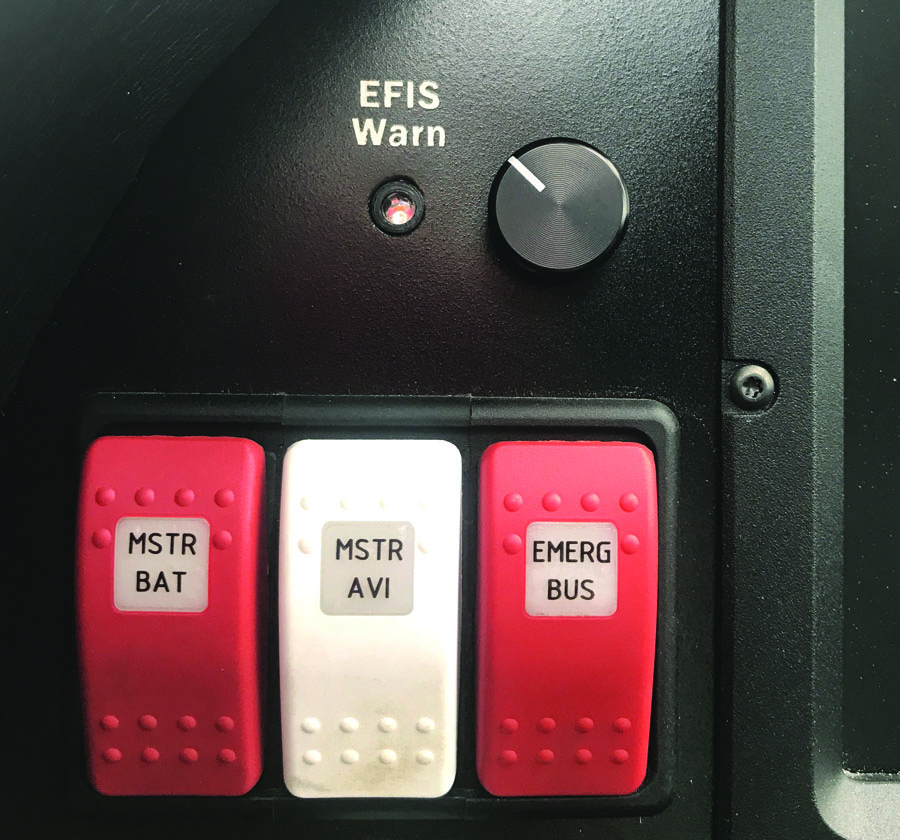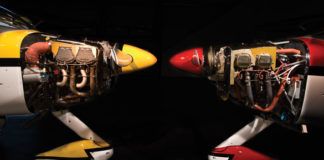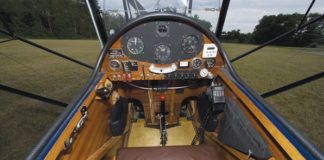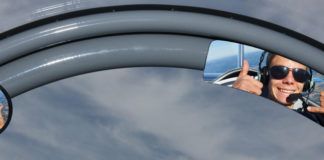The title of this month’s column almost sounds ominous, but in reality it is a practice that I have used many times in all of my years of flying. In the last few months alone, I have exercised it twice, and in one case it truly saved me from taking a course of action that could have had a less-than-happy outcome.
During our initial flight training we are constantly drilled in how to deal with emergencies, including everything from communications failures to engine stoppages. Really good flight schools have some sort of emergency scenario planned for every flight right up until the check ride, excluding solo flights, of course. That was a practice even when I learned to fly at Davis-Monthan Air Force Base in 1977. Even on my first solo flight, the right window of the C-152 trainer popped open right as I lifted off. There were no noise-cancelling headphones back then. In fact we didn’t use headsets at all! Yes, it was loud and distracting, but I just reached across the now-empty right seat, closed the window, and continued the flight. Truth be told, it wasn’t much of a reach in the C-152. I later heard from another instructor that it probably wasn’t an “accident” that the window popped open. Jerry, my instructor and the chief tower controller at the base, was known to look for ways to surprise his students. Good for him, as vigilance remains ingrained to this day. I still remember my first flight after achieving my Private Pilot certificate—I kept waiting for something to happen, as every flight prior to it had some kind of “emergency.”
As most of you know, the training for additional certificates and ratings also includes a lot of failure scenarios. Multi-engine training is a constant barrage of engine failures. During my training for a multi-engine rating back in the ’70s, it was common practice for the instructor to fail an engine at rotation by pulling the mixture back to idle cutoff. The student was expected to identify the failed engine, take the appropriate actions, and continue the flight. A simulated engine failure in a light twin right at rotation requires steps that need to done correctly and immediately. Most light twins cannot climb on one engine, and some can’t even hold level flight on one engine. Decision-making during these few critical seconds needs to be deliberate and correct.

Many checklists for general aviation aircraft have emergency procedures highlighted, which means the pilot should spend some time committing them to memory. Then once the actions are taken during an actual emergency, refer to the checklist to verify completion of the items.
During one particular training flight, I correctly identified the failed engine and proceeded to shut it down by closing the throttle, moving the propeller control to the feather position, and promptly pulling the mixture control to idle cutoff. Unfortunately, this time the instructor did not guard the mixture levers, and I proceeded to pull the only remaining mixture lever, which happened to be for the remaining good engine. Yep, it got kind of quiet, but luckily we had lots of runway left and no metal was bent. I never forgot that incident, and it had an impact upon how I reacted to emergencies as time progressed. The old adage about “looking at your watch first” is a good one, and I teach that approach and have practiced it myself many times. An engine failure at rotation probably doesn’t call for looking at your watch, but it can force you to slow down and take deliberate actions.
Today most multi-engine training programs only simulate engine failures close to the ground by creating a power condition that produces “zero” thrust, rather than completely cutting the fuel off.
Simulator training for airlines also includes emergency scenarios in every single session. Some of the scenarios require an action so immediate that it is constantly practiced until it can be executed flawlessly. For some emergencies, especially in the military and airline industries, there are memory items that need to be executed without reference to a checklist. If you can’t pass the memory test, you don’t even get to the simulator!
What Did I Just Do?
Here’s another approach that has saved my bacon a couple of times: I stop and ask myself what was the last action taken. Just a couple of months ago, I traveled to Phoenix, Arizona, to perform a prebuy on an RV-9. The prospective buyer was meeting me there in the hope that it would work out, and we could both then fly back to Bridgeport, Connecticut. I had two days in my schedule that could work, and we agreed that we would try to at least get it as far east as possible until weather interfered. Flight planning showed a total time en route of 14 hours. If the weather cooperated, this could be an easy couple of days. Unfortunately, by the time we finished the inspection, test flights, money transfers, and paperwork, it was 3 o’clock in the afternoon, with the temps hovering around 100 F. Not exactly an optimum time for a flight in the southwest desert.
Luckily, it was a dry day, with no summer afternoon cumulus, and the winds weren’t very strong. RVs are good climbers, and eastbound out of Phoenix to Albuquerque only requires climbing to 11,500 or 12,500 feet. We made it to Albuquerque quite uneventfully, and even the bumps were tolerable. There were some thunderstorms east of Albuquerque, which interfered with our planned next stop. However, Amarillo looked good, and we made the decision to continue, with the idea being we would arrive in Amarillo about 30 minutes after sunset. The aircraft was night legal, but not IFR legal, and I don’t like being out over the desert at night anyway. Thirty minutes after sunset is still light enough for me.
You know how every incident or accident has a chain? Well, this is where this chain starts—pressure to try and get 4 hours of flying in on day one, such that the 10 hours remaining for day two was achievable. In fact, the weather was severe clear from Amarillo to Bridgeport. So, off we headed, and as we flew east the skies were getting darker. The young, inexperienced pilot in the left seat kept telling me it was getting dark due to the clouds. I kept saying I had been flying long enough to recognize the dark of night, and it looked like night to me. The ceilings at Amarillo were now lowering to an unforecasted 1000 feet, and it was clearly dark. Really dark. Why? Because we were now 1 hour past sunset. The light bulb finally went off in my head that we had crossed into the Central time zone, and somehow I had missed that in my flight planning. I wasn’t happy, but no big deal, as we were only about 30 minutes from our destination. We had been following I-40 since we left Albuquerque, and it was well lit due to the amount of vehicular traffic.
Then it happened. I don’t remember who noticed it first, but both the oil pressure and the oil temperature gauges were showing a steady climb to the top of the gauges. It’s not a good feeling to see that over the desert at night. They both continued to climb until they were off-scale high, and the discussions started regarding a precautionary landing. I did not like the potential outcome of that scenario at all. Two thoughts jumped into my head: first, this engine had been running fine all day, for at least 3.5 hours and had no history of problems, and I had just given it a thorough inspection back in Phoenix. Second, high oil temp is usually accompanied by a decrease in oil pressure, not an increase. My next thought was, “What was the last thing I did?” and I even said it out loud. I remembered I had turned on the navigation lights about 30 minutes ago. So, I turned them off and, sure enough, both gauges returned to the normal readings we had seen all day. I could duplicate it by cycling the nav-light switch. What a relief! Problem solved. It was a wiring problem, probably a bad or daisy-chained ground. I have seen those problems before.
I was annoyed at the seller though, and a phone call that night when we landed confirmed he knew about the problem. He hadn’t flown it at night in over a year, he said, so he had forgotten about it. Quite candidly, this problem could be duplicated during the day by switching on the nav lights—a whole lot less stressful for sure!

Note the unlabeled knob next to the EFIS warn light. One might think it’s a volume knob. It turned out to be a servo-controlled oil cooler valve and almost lead to an unscheduled landing due to rapidly rising oil temps.
What’s This Knob For?
The second recent incident occurred when I was asked to relocate an RV-10 from Destin, Florida, to Atlanta due to an approaching hurricane. Upon arrival at Destin, I had the tanks topped (I won’t fly an unknown airplane without topping the tanks) and familiarized myself with the cockpit layout. I had actually licensed this airplane as a DAR a number of years ago, so I was comfortable with the build quality. Only one thing caught my eye, and that was an indicator light on the panel labeled “EFIS Warn” and an unlabeled knob next to it that had all of the appearances of a volume control or dimmer function. The owner was inaccessible, as he was on a sailboat in the Gulf behind the hurricane. With everything else good to go, the RV-6 pilot who brought me to Destin and I departed as a two-ship. Oil temp rose normally during the climb and then leveled off and proceeded to cool back down to around 183 once in level flight at 7500 feet. About 30 minutes into the flight, I noticed the oil temp was starting to steadily climb, about 1 every 15-20 seconds. When it got to 210, I radioed the RV-6 that I might make a precautionary landing to check out a rapidly rising oil temp indication. The difference with this scenario is that the oil pressure was decreasing, as it should with elevated oil temps. It was clear to me that the oil really was getting warmer. Perhaps a leak? The last thing I wanted to do was bend an airplane I was entrusted to move to safety.
Well, again I asked myself what was the last action taken? I looked around the cockpit and verified that all of the engine controls were in the same position. I scanned the panel, and as I began to turn toward the nearest airport, it jumped out at me—that unlabeled knob. I had been playing with it earlier to see if it did anything. Hmm. I hadn’t figured out what its function was, so I let it go. On a hunch I rotated it completely in the opposite direction from its current position. Within 15-20 seconds the oil temp immediately started decreasing and continued rather rapidly all the way back to 180! Boy, was I going to have a discussion when I landed. I was pretty certain this knob was not there when I licensed the airplane, as unlabeled controls are a pet peeve of mine. Sure enough, the builder admitted he had installed a servo-controlled oil cooler valve recently and had forgotten to label it.
There’s one other lesson in both of these for all of us who build airplanes. Yes, we get to personalize them, but we should build them and label things such that another pilot can get in it and safely fly it. It’s supposed to be fun. Let’s leave the emergency scenarios to the flight training flights.

![]()
Vic Syracuse is a Commercial Pilot, CFII with ASMEL/ASES ratings, an A&P, DAR, and EAA Technical Advisor and Flight Counselor. Passionately involved in aviation for over 40 years, he has built 11 aircraft and logged over 8700 hours in 72 different kinds of aircraft. Vic volunteers as a Young Eagle pilot and Angel Flight pilot. He chairs the EAA Homebuilt Council and is a member of EAA’s Board of Directors. He also has his own sport aviation business called Base Leg Aviation.













